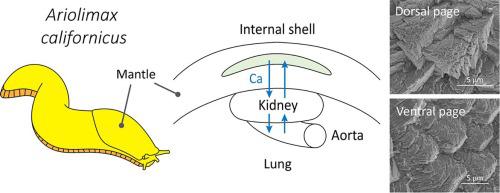Journal of Structural Biology ( IF 3.0 ) Pub Date : 2021-06-23 , DOI: 10.1016/j.jsb.2021.107764 Devis Montroni 1 , Janet Leonard 2 , Marco Rolandi 3 , Giuseppe Falini 4

|
A slug is a shell-less terrestrial gastropod mollusk. During evolution, slugs have lost their mineralized external shell but some of them have retained an internal shell (IS). Unlike external shells, which have been widely investigated, the ISs have been poorly studied. We report for the first time the compositional and complete morphological characterization of Ariolimax californicus’ IS. According to literature, this shell calcifies and decalcifies depending on the animal’s needs. Its composition is mostly organic, consisting of proteins and β-chitin. The internal shell is organized in layers and membranes in which CaCO3 crystal formation occurs in specific areas. In the two faces of the IS we observed different morphologies and aggregations of calcite bio-crystals along with a different organization of the organic matrix. Dorsally, the mineral forms a thick layer composed of misaligned crystal aggregates of large dimensions, separated by thin organic layers. This suggests a protective purpose and the use of this layer as a long-term calcium storage system. Ventrally, the mineral phase is organized in small crystal aggregates of comparable size, separated by thin organic layers, and quite aligned one to the other. The whole ventral mineral layer is covered by a membrane, identified as the hypostracum. This face is proposed to be a short-term calcium storage system. In vitro crystallization experiments suggest massive calcium ions sequestration from the solution for the precipitation of calcite crystals inside the organic matrix. In conclusion, this research provides new information on the dynamic of biomineralization on mollusk evolved in calcium-poor environments.
中文翻译:

Ariolimax californicus (Gastropoda; Stylommatophora) 内壳的形态和组织,一种不对称的双面生物矿化基质
蛞蝓是一种无壳的陆生腹足类软体动物。在进化过程中,蛞蝓失去了矿化的外壳,但其中一些保留了内壳(IS)。与已被广泛研究的外壳不同,IS 的研究很少。我们首次报告了Ariolimax californicus 的IS 的组成和完整的形态特征。根据文献,这种贝壳会根据动物的需要进行钙化和脱钙。它的成分主要是有机的,由蛋白质和β-几丁质组成。内壳被组织成层和膜,其中 CaCO 3晶体形成发生在特定区域。在 IS 的两个面上,我们观察到方解石生物晶体的不同形态和聚集以及有机基质的不同组织。背面,矿物形成由大尺寸错位晶体聚集体组成的厚层,由薄有机层隔开。这表明了保护目的以及将该层用作长期钙储存系统。在腹面,矿物相组织成大小相当的小晶体聚集体,由薄有机层隔开,彼此完全对齐。整个腹侧矿物质层被膜覆盖,称为下层。这张脸被提议作为一个短期的钙储存系统。体外结晶实验表明大量钙离子从溶液中螯合,以在有机基质内沉淀方解石晶体。总之,这项研究提供了有关在缺钙环境中进化的软体动物生物矿化动态的新信息。











































 京公网安备 11010802027423号
京公网安备 11010802027423号